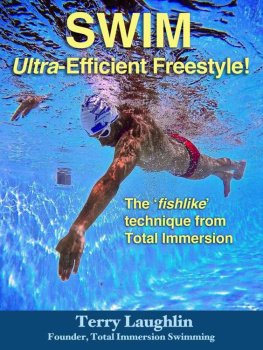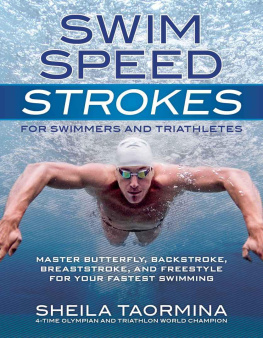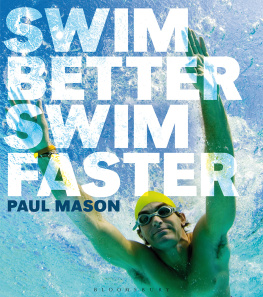C opyright 2015 by Terry Laughlin. All Rights reserved. No part of this book may be reproduced or transmitted in any form or by
any means electronic or mechanical, including photocopying, printing, recording, or by any information storage and retrieval system,
without permission in writing from Total Immersion, Inc. For information, contact Total Immersion Swimming, Inc., PO Box 370, New Paltz, NY 12561. Or email .
F or information about Total Immersion instruction, call 800-609-7946, or visit www.totalimmersion.net
F irst edition published 2015 .
T erry Laughlin , the founder and Head Coach of Total Immersion Swimming, is considered by many to be the worlds leading authority on how to swim efficiently. He was credited with revolutionizing how the Navy Seals teach swimming. The Army Rangers, Air Force Pararescue team, Coast Guard Rescue Swimmers, and U.S. Border Patrol have also sent instructors to Terry for Total Immersion training.
Terry showed little promise as a swimmer from age 12 to 20. In the fall of 1963, he was the only swimmer cut during tryouts for his grammar school team at St. Aidans in Williston Park NY. After completing the Red Cross 50-Mile Swim Challenge the next two summers at his village pool, he was better prepared when his high school, St. Marys in Manhasset NY, started a team two years later.
Terry could never escape the slow lane; his times were never good enough to qualify for the Catholic league championships. As a senior, he swam in the Novice championships, and earned his first medal, which remains a valued memento 45 years later. From 1968 to 1972, Terry swam for St. Johns University, enjoying modest success in distance events, but his final season was disappointing, and he felt almost relieved to retire as graduation approached.
Several months laterthough lacking in any obvious qualificationsTerry was offered the position of head coach at the U.S. Merchant Marine Academy in Kings Point NY. He became the youngest head coach in the NCAA at age 21.
From Day One, Terry displayed an instinct for helping others succeed where he had failedprimarily by emphasizing technique to a degree rare among swim coaches.
At the 1973 Metropolitan Collegiate Championships. Kings Point swimmers swept all freestyle eventsfive individual and two relayshattering league records in each, won nine of 18 events overallmore than any other schooland placed 2nd among 15 teams, despite having fewer swimmers than other schools. This performance earned Terry selection as Coach of the Yearat the same meet where hed finished far back in the pack as a swimmer just one year earlier.
In 1975, at age 23, Terry coached his first national championand national record-holderat the NCAA Division III Championships, This was the first national champion in the history of the Merchant Marine Academy, and the first of 24 national championsin virtually every event and at all distancesTerry would develop during his years of coaching club and college teams. Several of his swimmers also achieved World Top 10 rankings.
Terry left competitive coaching in 1989 to found Total Immersion, and has devoted himself to coaching adultsmostly new to swimmingever since.
In September 1988, Terry met the innovative coach Bill Boomer, whose unconventional ideascapsulized in the maxim the shape of the vessel matters more than the size of the engine in swimming would become the chief influence on how Terry would swim and coach forever after. Watch for the many references to vessel-shaping in the chapters that follow.
Terry also resumed swimming after a 17-year layoff, to synthesize the many lessons hed learned as a coach with this intriguing new idea of vessel-shaping. The success of these experiments was reflected in several Top 8 placings in distance events at Masters Nationals from 1989 to 1992a level of success far beyond what hed attained 20 years earlier. He also swam faster at age 41 than he had at 18, while training only half as much.
Terry stepped away from competitive swimming in 1992 to focus on developing Total Immersion techniques and managing a growing business. In 1996, he wrote the book Total Immersion: The Revolutionary Way to Swim Better, Easier, and Faster, to share the methods employed at TI workshops more widely. It has been the worlds top-selling book on swimming ever since.
Terry devoted 10 years to shaping his own vessel, acting as the primary guinea fish for refining the techniques taught at TI workshops. During this period he made a distinct shift from working out to practicing, and experienced marked gains in efficiency, insight, and self-perception. This led him to embrace the ethos of kaizena Japanese philosophy that no skill is ever static or fixed, but can be improved continuouslyand make it a TI core value.
In 2002, to celebrate having turned 50 a year earlier, Terry swam the 28.5-mile Manhattan Island Marathon. His decade of work on efficiency was reflected in completing a loop of Manhattan in 26,000 strokes (8 hours and 53 minutes at an average of 49 strokes per minute)compared to an average of 39.000 strokes for the rest of the field. On the strokes he saved, Terry could have swum another length of Manhattan! He completed the swim pain-free and felt fully recovered the next daydespite training about five hours, and 15,000 yards per weeka fraction of the training others had done.
After his Manhattan swimand a decade of vessel-shaping (see Chapters 5, 6, and 8)Terry began to focus on propulsion skills (see Chapters 7, 9, and 10). Four years later, at age 55, Terrys transformation as a swimmer culminated in a 4-month stretch of accomplishments that would have seemed wildly improbable 35 years earlier.
In May 2006, at U.S. Masters Nationals, he recorded pool times faster than hed seen in 13 years. During the open water season, between June and August, he completed his second Manhattan Island Marathon, much faster than before (and in 25,000 strokes); won four National Masters Open Water championships, from 1 mile to 10km; broke national records for the 1- and 2-Mile Cable Swims; and placed 8th in the World Masters Open Water Championship.
At 63, Terry is focused more on swimming for health and happiness than competitionthough he maintains a full schedule of open water events in the summer, including a swim across Gibraltar Straitsynchronizing TI strokes with two friendsin Oct 2013. One thing is unchanged: Terry still begins every swim (even the Gibraltar Crossing) with an explicit intention to improve his swimmingbelieving fully that he can be a better swimmer at the end of practice than at the beginning.
Introduction
T he techniques you will learn in this book represent the most significant forward leap in the history of the stroke commonly known as freestyle or front crawl. On the surface, the Total Immersion version of this popular stroke retains familiar elementsalternating arm and leg actions, and breathing to the side.









